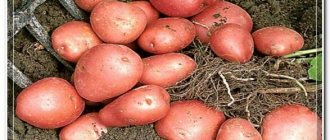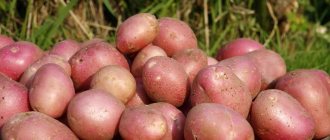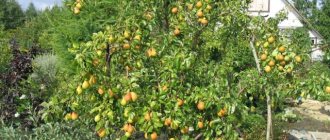“Zorachka” is one of the most famous early-ripening table potato varieties. The Zorachka potato is easy to care for and grows quickly, but to obtain a rich harvest, you will still need to take into account certain nuances. Zorachka is a well-known early-ripening potato variety that is considered in demand in home cooking. Early-ripening table potatoes have gained popularity and are ideal for beginners and experienced gardeners. “Zorachka” potatoes are considered one of the most popular among those who are actively involved in gardening and are interested in obtaining a high-quality, rich harvest.
Description of the potato variety Zorachka
The Zorachka potato variety was developed by Belarusian scientists. After lengthy research, it was approved for cultivation in the Central and Southern regions of Russia and post-Soviet countries. The optimal conditions for construction are a temperate climate without drought or excessive heat.
Zorachka potatoes are an early-ripening table variety; no more than 70 days pass from planting to harvesting. The plant forms a medium-sized, heavily leafy bush up to 60 cm high. Powerful shoots are covered with medium-sized dark emerald leaves. During flowering, the plant forms light blue inflorescences.
Thanks to the dense, thin peel, the crop is well transported over long distances. Despite the fact that the Zorachka variety is early ripening, its shelf life is 96% when stored at + 10 °C.
The variety is quite resistant to sudden changes in temperature and humidity conditions and develops well on any soil. But when grown on acidic soil and in dry weather, the root crop grows small and has poor taste.
Landing rules
The Zorachka variety should be planted in early May. If there is a threat of return frosts, be sure to cover the plantings with agrofibre so that the sprouts are not damaged. Maximum productivity can be achieved by growing these potatoes on loam with good aeration.
Site preparation should begin in the fall. It involves deep plowing with the addition of manure to the soil at the rate of 200 kg per hundred square meters. In case of increased acidity of the soil, you need to add more lime or dolomite flour.
With the arrival of spring, the bed should be dug up and the surface leveled. Holes for Zorachka potatoes should be made at a distance of 30 cm, and a distance of 60 cm should be maintained between rows. This planting scheme allows for high-quality hilling of the bushes and guarantees their uniform lighting and ventilation.
Important! It is recommended to additionally add a pinch of wood ash to each hole and mix it thoroughly with the soil.
Pros and cons of the Zorachka variety
According to reviews from gardeners, the Zorachka potato variety has many more positive characteristics than negative ones.
The advantages include:
- early ripening;
- high productivity;
- ease of care;
- good, rich taste and presentation;
- potatoes have high shelf life and transportability;
- tubers are not afraid of mechanical damage;
- The variety is resistant to many diseases.
Important!
For many summer residents, the negative qualities of Zorachka potatoes are the need for frequent watering and loosening the soil between rows. But if you lay a 15 cm layer of mulch on a potato bed, a minimum amount of time will be spent on watering, loosening and removing weeds.
Thanks to its good yield and high taste characteristics, Zorachka potatoes have become one of the most popular early-ripening varieties among Russian gardeners.
Characteristics
The climatic growing zone is: Russia, Belarus and Ukraine. The yield is average, about 70 t/ha. It has good taste, early, early ripening.
You can compare the yield indicators of Zorachka potatoes with other varieties in the table below:
| Variety name | Productivity |
| Beauty | 400-450 c/ha |
| Vector | 670 c/ha |
| Artemis | 220-350 c/ha |
| Yanka | up to 630 c/ha |
| Svitanok Kyiv | up to 460 c/ha |
| Santana | 160-380 c/ha |
| Nevsky | 300-500 c/ha |
| Taisiya | up to 460 c/ha |
| Colomba | 220-420 c/ha |
| Lapot | 400-500 c/ha |
The table potato variety Zorachka is not drought-resistant, prefers light loamy soils with neutral PH.
Due to the low starch content, the variety is relatively resistant to mechanical damage, resistant to potato blight, golden nematode, and average resistance to late blight.
Keeping quality is good, stored from July to January at t8-10 C.
The ability to store well is an important quality for potatoes. In the table below you will find this characteristic for different varieties:
| Variety name | Keeping quality |
| Timo | 96% |
| Arosa | 95% |
| Spring | 93% |
| Vineta | 87% |
| Impala | 95% |
| Zorachka | 96% |
| Kamensky | 97% |
| Latona | 90% |
| Lyubava | 98% |
| Luck | 88-97% |
The bush is low, with a medium stem, straight. The corolla of flowers is medium-sized, tightly gathered, bluish in color. The leaves are green, wavy along the edges, and medium in size.
Planting and caring for Zorachka potatoes
Zorachka potatoes are unpretentious in care and soil quality. But to get a good harvest, the soil must have neutral acidity; in dry weather, abundant, regular watering is required.
Selection and preparation of a landing site
An area with loamy, sandy loam, forest and peat soil is suitable for planting. Acidic, waterlogged and heavy soils are not suitable for growing Zorachka potatoes. The quality of the soil can be improved with lime, manure or sand.
Also, to obtain a generous harvest, it is necessary to observe crop rotation. Zorachka potatoes grow well after cabbage, carrots, beets and leafy vegetables.
The bed for planting is prepared in the fall. To do this, dig up the soil using a shovel and add organic and phosphorus-potassium fertilizers. Next, the soil is leveled and covered with mulch.
Preparation of planting material
Productivity and taste depend on correctly selected planting material. Potatoes for planting are selected during harvest, discarding deformed root crops. The optimal size should not exceed 6-8 cm in diameter.
The collected planting material is removed to a dry, warm room to dry. Next, the potatoes are placed in a box and left in the basement until spring.
Potatoes must be germinated 14 days before planting. For this:
- planting material is placed in 1 layer in a box and covered with shavings;
- for rapid germination, place the container in a warm place (+ 20 ° C) and regularly spray it;
- for better germination, potatoes are treated with ash infusion and dried;
- To protect the variety from diseases, potatoes are sprayed with fungicides before planting.
Landing rules
Potatoes are planted after the soil has warmed to + 10 °C. If the tubers have sprouted and strong sprouts have formed, then planting can be done when the soil warms up to 6 °C. Most gardeners plant potatoes according to the popular saying: “If foliage appears on the birch and poplar, then the soil is ready for planting.”
The yield of Zorachka potatoes depends on proper planting:
- The planting depth depends on the quality of the soil and the size of the planting material. Large specimens are planted deeper, small ones are placed closer to the surface. If the soil is light and fertile, the depth is 10 cm, heavy clay soil is 5 cm.
- In order for the bushes to grow and develop well, the interval is maintained at least 40 cm. If you plant more often, the stems will begin to interfere with each other and will stretch out. Also, the thickened planting will be poorly ventilated, resulting in late blight.
- If planting material of a non-standard size is selected, the distance is reduced to 25 cm.
During planting, complex mineral fertilizers and 1 tbsp are added to each hole. l. wood ash. To obtain a powerful, spreading bush, potatoes are planted with the sprout facing down. After planting, the holes are filled with nutrient soil.
Potatoes can be grown in several ways. The most common:
- Smooth planting is the most common method, which is suitable for flat areas without stagnant water. Use a shovel to lift a layer of earth, make a hole of the required size, lay a tuber and sprinkle it with earth.
- Planting in a ridge - in this way they are planted in a waterlogged area and at a high groundwater level. Using a walk-behind tractor, furrows are made 15 cm high at a distance of 70 cm.
- Planting in a trench is a method suitable for hot, arid climates.
- Planting in hay is an unusual, but very effective method. The tubers are laid out on the prepared bed, sprinkled with a small amount of soil and covered with hay. As the bush grows, straw is placed on the bed. Planting in hay makes harvesting easier and increases fruiting.
Advice! Regardless of which planting method is chosen, the main thing is to comply with agrotechnical rules in a timely manner.
Watering and fertilizing
Watering Zorachka potatoes is an important factor for obtaining a generous harvest. But after planting, while the root system is growing, the plantings are not irrigated. The first abundant watering is necessary when the tops reach 20 cm. Regular irrigation is also necessary during budding, since tubers begin to form during this period. If you do not provide the bush with the necessary amount of moisture, the growth and development of root crops will stop, and the tops will begin to dry.
In order for the plant to receive a sufficient amount of liquid, up to 4 liters of water are poured under each bush so that the soil is moistened to a depth of 30 cm. If a dry, hot summer is expected, after irrigation the soil is loosened and mulched.
Advice! After flowering ends, watering is reduced, as excess moisture can lead to late blight.
Timely feeding affects the formation of tubers, taste and shelf life. To achieve the expected result, fertilizing must be applied according to the rules:
- During the growth period of the tops, 1 liter of urea and 250 g of humus are diluted in 10 liters of water. Each bush is fed with 1 tbsp. prepared solution.
- In the bud formation phase, take 50 g of potassium sulfate and 250 g of ash into a bucket of water, mix everything thoroughly. Fertilizer is introduced under each bush in a volume of 250 ml.
- During the period of active flowering, to quickly form a crop, 50 g of potassium sulfate is diluted in a bucket of water. For each plant use 1 tbsp. prepared fertilizer.
Loosening and weeding
Loosening is necessary for better air flow into the lower layers of the soil, as this has a positive effect on the quality and quantity of the crop. Together with loosening, weed removal is carried out. Since weeds are carriers of diseases and bait for insect pests. Weeding is done before the emergence of shoots; later the tops will grow and will not allow weeds to appear.
Hilling
Experienced gardeners recommend hilling potatoes of the Zorachka variety several times a season. This procedure will not only enrich the soil with oxygen, but also prevent the appearance of potato moths.
The first hilling is carried out when the tops reach 15 cm. To protect the plantings from returning spring frosts, the plant is completely covered with earth. If frosts are not expected, an earthen mound is made at ½ the height of the bush.
After 2 weeks, the procedure is repeated. This must be done before the buds appear, since during flowering tubers begin to form, and when hilling, mechanical damage can easily be caused. How does hilling affect the plant:
- protection from spring frosts and summer heat;
- stimulation of the growth of additional root crops;
- soil drainage;
- improved aeration;
- destruction of insect larvae and removal of weeds.
Features of cultivation
Plantings need to be moistened regularly in the absence of seasonal rains. Therefore, the best option may be drip irrigation 2 times a week, and in hot periods - every other day. After each irrigation, you need to loosen the soil to ensure air access to the roots.
Zorachka bushes should be earthed up for the first time when the shoots grow to a height of 15 cm. The procedure must be repeated 10 days after this. During the growth process, weeds should be removed so that they do not take nutrition and moisture from the soil. Carry out weeding until the bushes close together in the row.
The accelerated pace of development of Zorachka potatoes requires timely application of fertilizers. The first time fertilizing should be done during the period of active growth of green mass. At this time, it is recommended to use ammonium nitrate or nitroammophoska. Fertilizers can be applied in the form of a solution at the rate of 30 g per 10 liters or dry method with further incorporation into the soil.
The bushes should be fed the second and third time during the period of budding and ovary. To do this, use superphosphate (40 g) and potassium sulfide (25 g) in a bucket of water. Fertilizers can be applied by root and foliar methods.
Important! After flowering, it is necessary to reduce watering of plantings to prevent the development of fungal diseases.
The optimal planting depth for Zorachka is 8-10 cm
Diseases and pests
From the description it is clear that Zorachka potatoes have strong immunity to nematodes and cancer, average resistance to late blight of tops and tubers, and are often exposed to the Y-virus.
- Late blight - the disease begins to develop at an air temperature of + 15-20 ° C and a humidity of about 90%. The main signs of the disease are dark spots on the outside of the leaf and white spots on the inside. Fungal spores quickly spread to neighboring plants with wind and raindrops. When the first signs of the disease appear, it is necessary to immediately get rid of the plant, since the disease cannot be cured.
- Y-virus is one of the serious diseases affecting productivity. When the virus appears, fruiting is reduced by 70%. The first signs of the disease: dark brown angular necrosis of the foliage, yellowing, curling and falling of the leaf blade. The viral disease cannot be treated and is transmitted by insect pests.
Selection history and growing regions
The Zorachka variety was patented by Belarusian breeders, and since 2013 it has been in the State Register of the Republic of Belarus. Since the same year, the variety has been listed in the State Register of Breeding Achievements of the Russian Federation. Although the vegetable can be cultivated in any area with a temperate climate, the recommended regions for its cultivation are the Northwestern and Central regions.
Did you know? Belarusians are considered the world leaders in potato eating, which is why they are often called “bulbash” - in the Belarusian language the word potato sounds like “bulba”.
Harvesting and storage
Zorachka potatoes are an early ripening variety; the first harvest can be harvested 50 days after emergence. The shelf life of root crops depends on compliance with the collection rules. After the tops dry out, do the first test digging of root crops. If the potatoes correspond to the varietal size, you can begin harvesting. To do this, dig the plant with a pitchfork, carefully pull it out of the ground, collect the tubers and place it in a prepared container.
Important! Harvesting is carried out in dry, warm weather.
Before sending the harvest for storage, potatoes are selected, removing damaged, deformed and rotten specimens. After treatment with copper sulfate, the selected crop is removed to a cool, dry place where the temperature does not rise above + 4 °C.
Reviews
Svyatik_RF
I tried the variety for the first time 3 years ago. Still haven't changed it. I really like its ease of care and resistance to transportation. Since I have to transport it far from the dacha, this factor is the most important for me. At home (in an apartment) it is stored almost until the month of May. Which is very good. I thought that “Zorachka”, like all the others, should be watered often, but my mother said that it was better to just spray it more often. So I did. The harvest is good. Enough for me and my dad to last all winter.
Grin_Pes
I have a very strange and incomprehensible soil at my dacha, because excavations were carried out about 10 years ago and even archaeologists could not understand its exact composition. Therefore, it has always been difficult for me to choose potatoes that will bear fruit normally. But after so many years, I found it. “Zorachka,” even though it was grown in Belarus, has taken root very well with me. It is very easy to grow and gives a good harvest. I recommend.
Rules for planting crops
The rules for planting Zorachka potatoes take into account crop rotation. Includes digging and fertilizing the soil, preparation, embedding tubers in the soil in compliance with the timing of agrotechnical work.
Deadlines for planting work
For planting potatoes, information about soil temperature is important. The roots of Zorachka tubers begin to germinate at +7 °C and above, so the activity is carried out at a stable average daily air temperature of at least +8 °C.
If you plant tubers in the soil ahead of time, the risk of rotting will increase.
In central Russia, the vegetable is planted in sunny, warm weather in early May. Pay attention to soil moisture. If there was heavy rain the day before, wait until the ground dries out.
Preparing the soil and site
Preparing the soil and site for spring planting begins immediately after harvesting the previous year's crop. First, the remaining tops and weeds are dried and burned. Drainage ditches are dug along the perimeter of the site. Check the acidity of the soil. If sorrel and horsetail are noticed in the beds, slaked lime, sulfur or sand are added to the soil.
The soil is dug up on the bayonet of a shovel, adding manure at the rate of 8 kg per 1 sq. m. m. In spring, the soil is loosened to a depth of 10–15 cm. Mineral fertilizers are applied per 1 hectare of land:
- 2 kg of potassium sulfate;
- 1 kg of ammonium nitrate;
- 4 kg of nitrophoska;
- 1 kg double superphosphate.
With a small planting area, manual digging of soil is more effective than mechanized digging.
Preparation of planting material
3–4 weeks before planting, seed material is removed from storage. A simple and affordable method of germination is in the light.
The technology consists of the following procedures:
- The tubers are sorted, removing diseased, rotten or deformed specimens.
- healthy potatoes are laid out on the floor or in boxes in 1–2 layers, after being sprayed with a solution of manganese (1 mg per 1 liter of water);
- for the first 10 days, planting material is kept indoors at a temperature of 18–20 °C;
- To prevent the sprouts from stretching, the potatoes are transferred to another place with a temperature of 10–13°C.
Immediately before planting, the sprouted tubers are treated with the growth stimulator Kornevin and the complex insecticidal and fungicidal preparation Prestige.
Scheme and depth of planting seedlings
Zorachka potatoes are planted in holes 8–10 cm deep, located at a distance of 40 cm from each other. Row spacing is 60 cm.
History of origin of the variety
Potato Scarb was bred in Belarus by Z.A. Semenova, L.I. Pishchenko, E.G. Ryndina and A.E. Zuykov. Breeders developed the variety at the Research Institute of Potato and Horticulture in 1997.
In 2002, the variety was officially included in the Russian state register. It became permitted to import it into the country, grow and sell planting material. It is most optimal to plant tubers in the Ural, Volga-Vyatka, Central, and Northwestern regions of the Russian Federation. Scarb potatoes are popular in Belarus, Moldova, and Ukraine.
Advantages and disadvantages
The main advantages of the Zorachka variety:
- High yield. From one hectare you can harvest about 30 tons of potatoes;
- Early ripeness. Tubers can begin to be collected on the 45th day, and full maturity occurs on the 80th day;
- The variety grows on almost any fertile soil and is unpretentious to the climate;
- Easy to care for.
- High taste qualities.
- It tolerates transportation well and is resistant to external influences;
- Has a long shelf life (96% of potatoes are preserved);
- Rarely gets sick. Resistant to potato diseases: namatode, cancer and fungal infections.
It has no strong drawbacks. Requires frequent loosening and does not tolerate drought.











